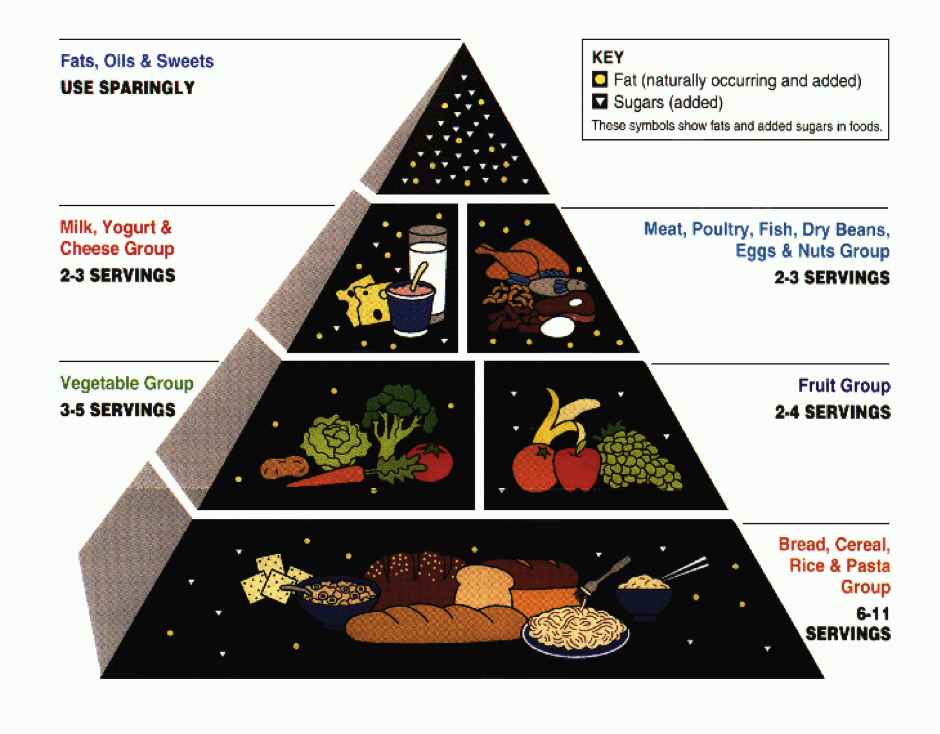A food pyramid is nothing but a pyramid shaped guide of healthy eating. It has major food groups divided into sections to show the recommended intake for each food group.
The concept of food pyramid started in Sweden in 1974 but the most widely known and accepted food pyramid was introduced by the United States Department of Agriculture in 1992, was updated in 2005, and then replaced with “MyPlate” in 2011.
Despite as many as 25 countries publishing their own version of food pyramid, the basic purpose is to recommend “A Balanced Diet” – A balanced diet is made up of foodstuffs from difference food groups:
- Cereals and pulses (including breads)
- Fruits and vegetables
- Milk and dairy products
- Meat, poultry, fish, eggs
- Sugar/sweets
- Nuts and oilseeds
- Fats and oil
- Cereals and grains form the base of the food pyramid which means that this group of foods should form the largest part of the meal. It should be combined with pulses not only to improve the protein quality but also to get sufficient calories and other nutrients. 45-50% of calories are obtained from cereals with 10-15% of calories being obtained from pules.
- The next group is fruits and vegetables. This group adds colour, flavour, variety and lots of health benefits. Calorie contribution from this group should be quite significant i.e. 20-25%. If fruits & vegetables are eaten raw-in the form of salads, chaat, vegetables soups, raita etc.- They are even more beneficial.
- Milk and milk products are next in importance in a balanced diet. 20-25% of calories should be obtained from this group. For non-vegetarian, milk can be substituted by meat, fish and poultry. Vegetarians can also consume nuts and oilseeds along with milk and milk products. Also they can substitute beans, peas, legumes etc.
- Fats, oils and sugars occupy the narrowest part of the food pyramid which means their intake in the diet should be very minimal. 10% of calories should be obtained from them.
|
Classification of foods into groups with examples & major nutrients supplied |
||
|
FOOD GROUPS |
EXAMPLES |
MAIN NUTRIENT |
| Cereals | Rice, wheat, Ragi, Bajra, Maize, Jowar, Barley, rice flakes,wholewheat flour, wheat bread, multi grain bread, cereals, cornflakes, wheat flakes, muesli, white oats, brown rice, . | Energy, Protein, Invisible fat, Vitamin B1, Vitamin B2, Folic acid, Iron, Fibre. |
| Pulses/Legumes | Whole dals: moong, chana (kabuli, brown, green), rajma, matki, mauth, urad, masoorSplit dals: moong, urad, tuvar, chanaOther: Soybean, sprouts | Energy, Protein, Invisible fat, Vitamin B1, Vitamin B2 Folic acid, Calcium, Iron, Fibre |
| Fruits | Citrus fruits: grapes, oranges, sweet limes, lemons, etcOther: melons, peaches, pineapples, strawberries, papya, appleHigh carbohydrates fruits: banana, mango, chikoo(sapota), custard apple | Carotenoids, Vitamin C, B2, Folic acid, Iron, FibreCalcium, |
| Vegetables | Green leafy: spinach, fenugreek, coiander, mint, amaranthRoots & tubers: carrots, potatoes, sweet potatoes, ginger, beetroot, raddishOther: cauliflower, beans, pumpkin, tinda, brinjal, ladies finger | Carotenoids, Vitamin C, B2, Folic acid, Iron, FibreCalcium, |
| Milk & milk products | Full strength, toned or double-toned milk, curd or buttermilk,skimmed milk, cheese, fruit yogurt, shrikhand, cottage cheese (paneer) | Protein, Fat, Vitamin B2, Calcium |
| Meat, poultry & fish | Mutton, chicken, fish, prawns, oysters, eggs, beef, pork.Lean meat vs Organ meats | Protein, fat, Vitamin B2 |
| Nuts, dried fruits & oilseeds | Almond, walnuts, cashew nuts, peanuts, coconut, sunflower seeds, flaxseeds, pistachios, raisins | |
| Fats & oils | Oil, ghee, butter, margarine, vanaspti, cream | Energy, Fat, Essential Fatty acids. |
| Sugars & sweets | Sugar, sweets, biscuits, cookies, cakes, pastries, honey, jaggery, desserts, mousse, pies, chocolates, sugar syrup | Energy |
Modified to include Exercise as an integral part of healthy eating and lifestyle

Modified in 2011 to “MyPlate”
On 2nd June 2011, MyPlate replaced the USDA’s MyPyramid guide, ending 19 years of Food Pyramid. MyPlate is displayed on food packaging and used in nutrition education in the United States.

MyPlate is divided into sections of approximately 30% grains, 30% vegetables, 20% fruits and 20% protein, accompanied by a smaller circle representing dairy, such as a glass of low-fat/nonfat milk or a yogurt cup.
It is supplemented with additional recommendations, such as
– Make half your plate fruits and vegetables
– Switch to 1% or skim milk
– Make at least half your grains whole
– Vary your protein food choices.
The guidelines also recommend portion control while still enjoying food, as well as reductions in sodium and sugar intakes.
The idea behind MyPlate is very practical and stated by First Lady Michelle Obama, when she launched MyPlate, “Parents don’t have the time to measure out exactly three ounces of chicken or to look up how much rice or broccoli is in a serving. … But we do have time to take a look at our kids’ plates. … And as long as they’re eating proper portions, as long as half of their meal is fruits and vegetables alongside their lean proteins, whole grains and low-fat dairy, then we’re good. It’s as simple as that”

Time to follow either the Pyramid or MyPlate 🙂



Food plate is a great improvement over food pyramid as far as consumer understanding is concerned.